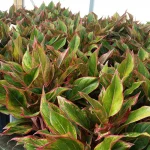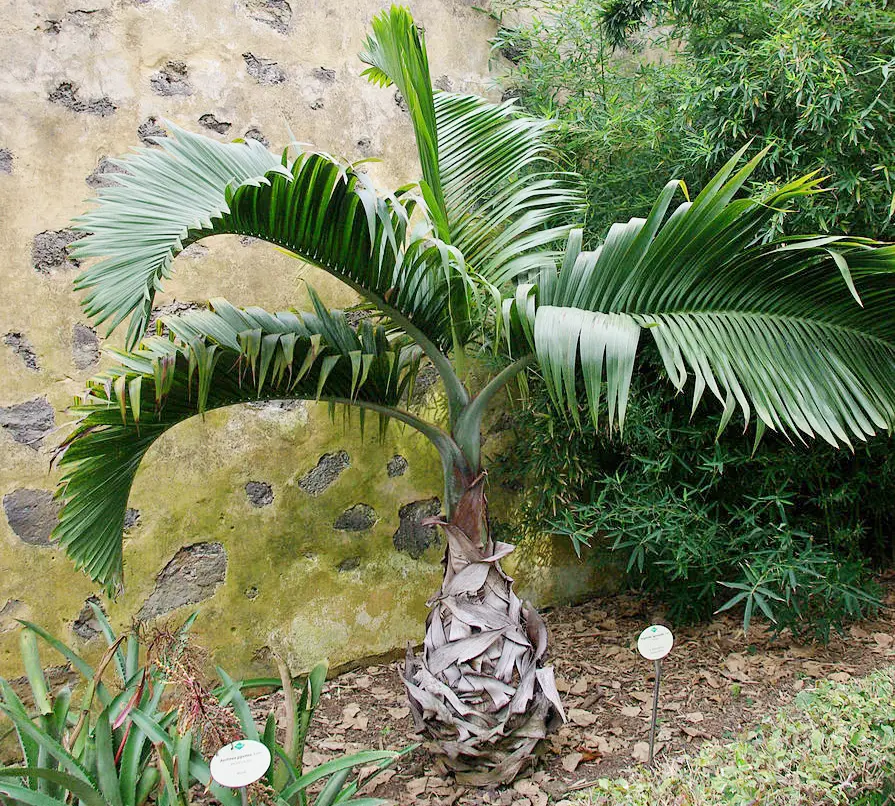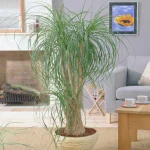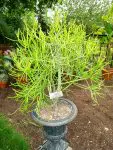This post contains affiliate links. If you buy something from one of our links we may earn a commission. Thanks
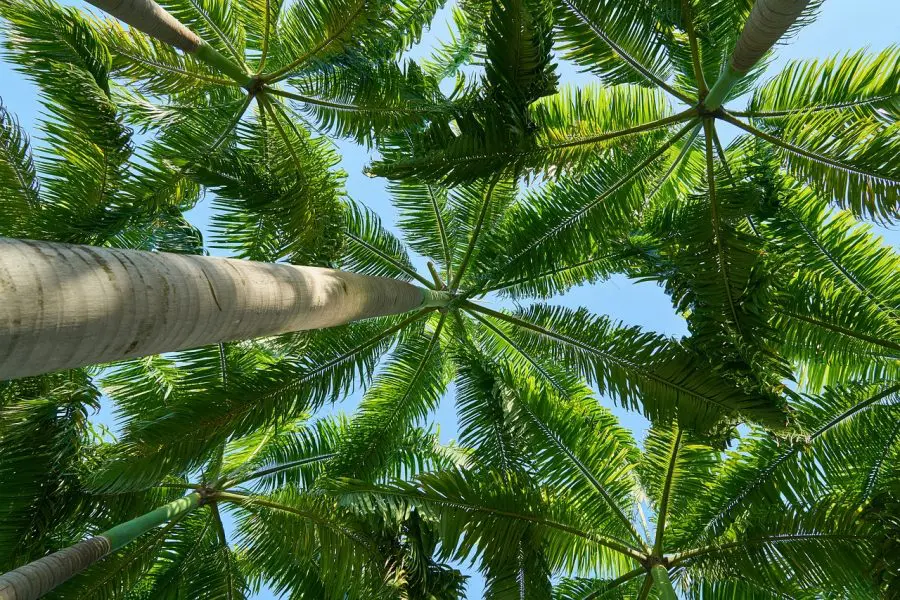
Indoor palm trees not only add a touch of tropical flair to your home but also bring numerous benefits to your indoor environment.
However, to keep your indoor palm plants thriving and in good health, it’s important to give them the indoor palm tree care they deserve.
Indoor palm tree care requires a balanced approach to ensure healthy growth. Provide bright, indirect light, consistent watering, and well-draining soil. Ensure a humid environment and keep them away from drafts or heaters. Regularly clean the leaves and monitor for pests. Fertilize lightly during the growing season, and repot every other year or when roots become crowded.
From providing the right amount of light and water to controlling pests and diseases, the key to a lush and verdant indoor palm tree lies in understanding its unique needs.
Overview
Indoor palm trees are a popular choice for adding a touch of tropical greenery to our homes. Not only do they enhance the aesthetic appeal of our living spaces, but they also bring numerous benefits to our indoor environment.
In this guide, we will explore the importance of indoor palm trees, their various species, and the basics of indoor palm tree care.
Whether you’re an experienced plant grower or just starting your indoor gardening journey, this guide will provide you with all the information you need to keep your indoor palm trees healthy and thriving.
What Are Palm Trees?
Palm trees are a group of plants in the family Arecaceae, commonly found in tropical and subtropical regions. They are known for their distinctive tall, slender trunks and large feather-like leaves at the top. There are over 2,500 species of palm trees, each with unique features and growth patterns. Some of the most popular species include the coconut palm, date palm, and kentia palm. In addition to being a staple in the tropical landscape, many species of palm trees can also be grown as indoor plants for their ornamental value and air-purifying benefits.
The Arecaceae is a family of perennial flowering plants in the monocot order Arecales. Their growth form can be climbers, shrubs, tree-like and stemless plants, all commonly known as palms. Those having a tree-like form are called palm trees. Currently, 181 genera with around 2,600 species are known, most of which are restricted to tropical and subtropical climates. Most palms are distinguished by their large, compound, evergreen leaves, known as fronds, arranged at the top of an unbranched stem. However, palms exhibit an enormous diversity in physical characteristics and inhabit nearly every type of habitat within their range, from rainforests to deserts.
Palms are among the best known and most extensively cultivated plant families. They have been important to humans throughout much of history. Many common products and foods are derived from palms. In contemporary times, palms are also widely used in landscaping. In many historical cultures, because of their importance as food, palms were symbols for such ideas as victory, peace, and fertility. https://en.wikipedia.org/wiki/Arecaceae
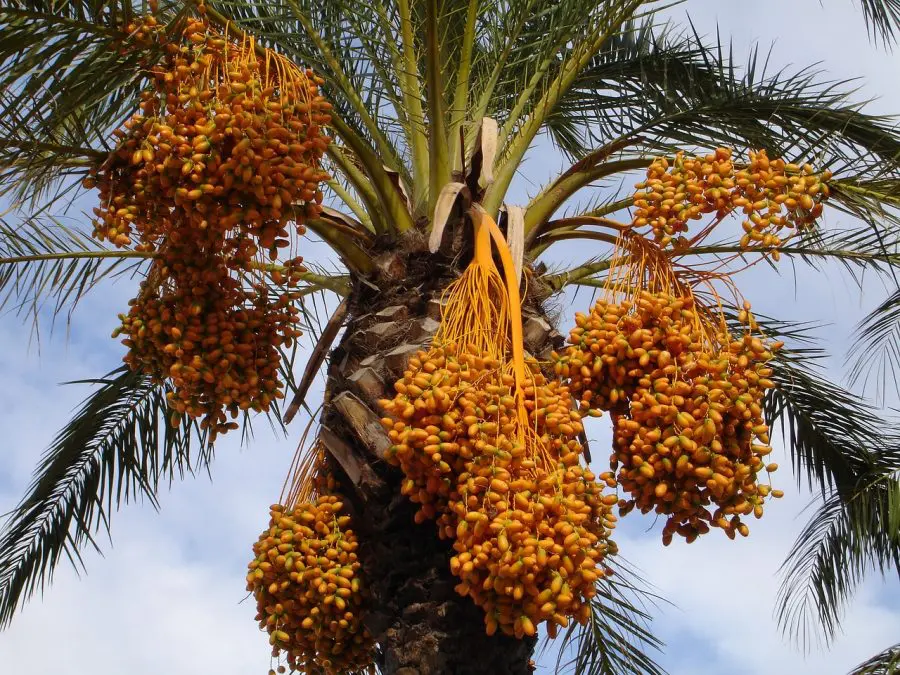
Importance of Indoor Palm Trees:
Indoor palm trees are not only aesthetically pleasing, but they also play a crucial role in improving our indoor environment.
These plants are known for their ability to purify the air, reduce indoor pollutants, and improve humidity levels.
Indoor palm trees can also help create a more relaxed and calming atmosphere and have been shown to reduce stress and improve overall mood.
The Benefits of Having Indoor Palm Trees:
Having indoor palm trees in your home or office can bring numerous benefits to your indoor environment.
These plants are known to help purify the air by removing harmful chemicals and pollutants and improving air quality.
Indoor palm trees can also help regulate humidity levels, making them ideal for dry indoor spaces.
In addition, having indoor palm trees has been shown to have a positive impact on mental health, reducing stress and improving overall mood. They are also easy to care for, making them a great choice for plant parents of all levels.
The benefits of keeping indoor palm trees
There are several key benefits to keeping indoor palm trees in your home or office:
• Improved air quality: Indoor palm trees are effective at removing harmful chemicals and pollutants from the air, improving the air quality in your indoor spaces.
• Increased humidity levels: Indoor palm trees can help regulate humidity levels, making them ideal for dry indoor spaces.
• Stress reduction: Studies have shown that having indoor palm trees can have a positive impact on mental health, reducing stress and improving overall mood.
• Aesthetic appeal: Indoor palm trees are visually appealing and can add a touch of tropical greenery to any indoor space.
• Easy maintenance: Many species of indoor palm trees are low-maintenance, making them a great choice for busy plant parents or those who are just starting their indoor gardening journey.
• Versatility: There is a wide variety of indoor palm trees to choose from, making it easy to find one that fits your specific indoor space and decor style.
• Improved physical health: Indoor palm trees can help improve physical health by reducing allergens and irritants in the air, and by reducing the amount of carbon dioxide in the air.
• Increased property value: Indoor palm trees can also add value to your property by enhancing its overall aesthetic appeal.
In conclusion, keeping indoor palm trees has numerous benefits that can improve the air quality, aesthetic appeal, and overall well-being of your indoor environment.
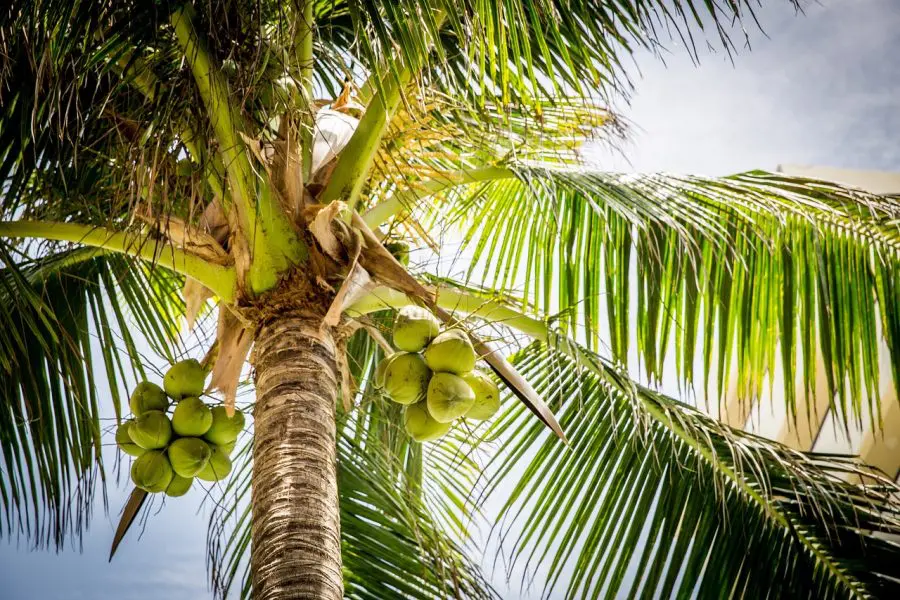
II. Types of indoor palm trees
Indoor palm trees come in a wide variety of species, each with its own unique characteristics and needs.
From tall, towering specimens to compact, tabletop plants, there is an indoor palm tree suitable for every indoor space.
In this section, we will explore some of the most popular types of indoor palm trees, their specific characteristics, and the conditions they need to thrive.
Whether you’re looking for a plant that can tolerate low light or one that is easy to care for, this guide will help you choose the right indoor palm tree for your home or office.
It is best to buy palm trees by their scientific names as using common names can lead to buying the wrong palm species.
A List of Popular Indoor Palm Tree Species:
Some of the most popular species of palm trees for indoors include the following:
• Areca Palm – Dypsis lutescens
• Kentia Palm – Howea forsteriana
• Parlour Palm – Chamaedorea elegans
• Bamboo Palm – Chamaedorea seifrizii
• Fishtail Palm – Caryota sp.
• Majesty Palm – Ravenea rivularis
• Sago Palm – Cycas revoluta
• Chinese Fan Palm – Livistona chinensis
• Ponytail Palm – Beaucarnea recurvata
• Lady Palms – Rhapis excelsa
• Pygmy Date Palm – Phoenix roebelenii
• European Fan Palm – Chamaerops humilis
• Cat Palm – Chamaedorea cataractarum
• Chinese windmill Palm – Trachycarpus fortunei
Some Characteristics of Each Species:
 Areca Palm: The Areca Palm is known for its tall stature and feathery fronds, and is often used to create a tropical atmosphere.
Areca Palm: The Areca Palm is known for its tall stature and feathery fronds, and is often used to create a tropical atmosphere.
 Kentia Palm: The Kentia Palm is a slow-growing species that is known for its elegant, arching fronds and ability to thrive in low-light conditions.
Kentia Palm: The Kentia Palm is a slow-growing species that is known for its elegant, arching fronds and ability to thrive in low-light conditions.
 Parlour Palm: The Parlour Palm is a compact species with small, delicate fronds that is well-suited to tabletop or windowsill gardens.
Parlour Palm: The Parlour Palm is a compact species with small, delicate fronds that is well-suited to tabletop or windowsill gardens.
 Bamboo Palm: The Bamboo Palm is a tall, bushy species that is known for its ability to purify the air and reduce indoor pollutants.
Bamboo Palm: The Bamboo Palm is a tall, bushy species that is known for its ability to purify the air and reduce indoor pollutants.
 Fishtail Palm: The Fishtail Palm is a slow-growing species with unusual, fishtail-shaped fronds that adds a unique touch to indoor spaces.
Fishtail Palm: The Fishtail Palm is a slow-growing species with unusual, fishtail-shaped fronds that adds a unique touch to indoor spaces.
 Majesty Palm: The Majesty Palm is a large, fast-growing species that is often used as a privacy screen or room divider.
Majesty Palm: The Majesty Palm is a large, fast-growing species that is often used as a privacy screen or room divider.
 Sago Palm: The Sago Palm is a compact species that is well-suited to smaller indoor spaces and is known for its unique, tropical look. It is actually very slow growing. Although it looks like a palm it is not a true palm and is actually a cycad.
Sago Palm: The Sago Palm is a compact species that is well-suited to smaller indoor spaces and is known for its unique, tropical look. It is actually very slow growing. Although it looks like a palm it is not a true palm and is actually a cycad.
 Pygmy Date Palm: The Dwarf Date Palm is a compact species that is well-suited to tabletop gardens and is known for its elegant, arching fronds.
Pygmy Date Palm: The Dwarf Date Palm is a compact species that is well-suited to tabletop gardens and is known for its elegant, arching fronds.
 Chinese Fan Palm: The Chinese Fan Palm is a slow-growing species with large, fan-shaped fronds that adds a touch of exotic beauty to indoor spaces.
Chinese Fan Palm: The Chinese Fan Palm is a slow-growing species with large, fan-shaped fronds that adds a touch of exotic beauty to indoor spaces.
 Ponytail Palm: also known as Beaucarnea recurvata, is a slow-growing plant that is recognizable for its unique, curly leaves that resemble a ponytail. The Ponytail Palm is native to Mexico and is known for its ability to store water in its thick, bulb-like base.
Ponytail Palm: also known as Beaucarnea recurvata, is a slow-growing plant that is recognizable for its unique, curly leaves that resemble a ponytail. The Ponytail Palm is native to Mexico and is known for its ability to store water in its thick, bulb-like base.
 Lady Palms: also known as Rhapis excelsa, are a popular species of indoor palm trees due to their attractive appearance and low maintenance needs. This species of palm is native to Southeast Asia and is known for its delicate, fan-like leaves and slow growth rate.
Lady Palms: also known as Rhapis excelsa, are a popular species of indoor palm trees due to their attractive appearance and low maintenance needs. This species of palm is native to Southeast Asia and is known for its delicate, fan-like leaves and slow growth rate.
 European Fan Palm: also known as Chamaerops humilis, is a hardy species of palm tree native to the Mediterranean region. This species is recognizable for its fan-like leaves and its ability to grow in a variety of climates, making it a popular choice for indoor or outdoor use.
European Fan Palm: also known as Chamaerops humilis, is a hardy species of palm tree native to the Mediterranean region. This species is recognizable for its fan-like leaves and its ability to grow in a variety of climates, making it a popular choice for indoor or outdoor use.
 Cat Palm: also known as Chamaedorea cataractarum, is a compact species of indoor palm that is native to Mexico. This species is popular for its attractive appearance and its ability to grow in low-light conditions.
Cat Palm: also known as Chamaedorea cataractarum, is a compact species of indoor palm that is native to Mexico. This species is popular for its attractive appearance and its ability to grow in low-light conditions.
 Chinese windmill Palm: also known as Trachycarpus fortunei, is a species of palm tree that is native to Asia. This species is known for its hardy nature and its ability to tolerate cold temperatures, making it a popular choice for indoor or outdoor use in many regions.
Chinese windmill Palm: also known as Trachycarpus fortunei, is a species of palm tree that is native to Asia. This species is known for its hardy nature and its ability to tolerate cold temperatures, making it a popular choice for indoor or outdoor use in many regions.
 The Bottle Palm: Hyophorbe lagenicaulis is a tropical, evergreen palm species native to Madagascar. It gets its name from its distinctive, bottle-shaped trunk which can grow up to 8 feet tall and 6 inches in diameter. This palm tree has a compact, slow-growing habit and produces lush green, pinnate leaves that grow up to 3 feet long. The Bottle Palm is a popular choice for indoor gardens, outdoor gardens, and patio areas as it’s relatively easy to care for and adds a tropical touch to any space.
The Bottle Palm: Hyophorbe lagenicaulis is a tropical, evergreen palm species native to Madagascar. It gets its name from its distinctive, bottle-shaped trunk which can grow up to 8 feet tall and 6 inches in diameter. This palm tree has a compact, slow-growing habit and produces lush green, pinnate leaves that grow up to 3 feet long. The Bottle Palm is a popular choice for indoor gardens, outdoor gardens, and patio areas as it’s relatively easy to care for and adds a tropical touch to any space.
 Queen Palm: Queen Palms are not only a staple in tropical landscapes, but they can also add a touch of the exotic to indoor spaces. These stunning plants, also known as Syagrus romanzoffiana, have long, feathery fronds that sway gracefully in the breeze, making them favorite indoor palms among indoor plant enthusiasts.
Queen Palm: Queen Palms are not only a staple in tropical landscapes, but they can also add a touch of the exotic to indoor spaces. These stunning plants, also known as Syagrus romanzoffiana, have long, feathery fronds that sway gracefully in the breeze, making them favorite indoor palms among indoor plant enthusiasts.
Differences Between Species:
Each species of indoor palm tree has its own specific characteristics and needs, making it important to choose the right one for your indoor space.
Some indoor palm trees are tall and bushy, while others are compact and well-suited to tabletop gardens.
Some species thrive in low-light conditions, while others require bright, indirect light. Understanding the differences between each species will help you make the right choice for your indoor environment.
III. Location & Lighting
The location and lighting conditions in which you keep your indoor palm tree play a crucial role in its overall health and well-being.
Different species of indoor palm trees have varying requirements for light, and choosing the right location and lighting conditions can make all the difference in keeping your plant happy and healthy.
In this section, we’ll explore the importance of location and lighting for indoor palm trees and provide tips for ensuring your plant receives the right amount of light and environmental support it needs.
Choosing An Ideal Location for Indoor Palm Trees:
When it comes to choosing the ideal location for an indoor palm tree, it’s important to consider factors such as temperature, humidity, and access to natural light.
A warm, bright room with high humidity is ideal for most indoor palm trees, but specific requirements may vary depending on the species.
Avoid placing your indoor palm tree in areas with cold drafts, direct sun exposure, heating, air conditioning vents, or low humidity levels.
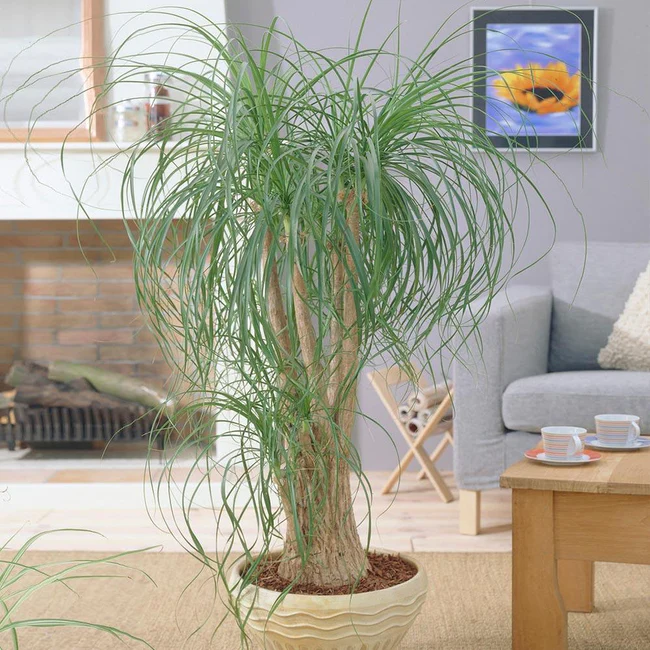
Importance of Natural Light:
Natural light is essential for the growth and health of indoor palm trees. Most indoor palm trees require bright light to thrive, although specific requirements may vary depending on the species.
If you’re unable to provide adequate natural light, consider using artificial lighting to supplement the plant’s needs. Most palms will do well placed near a south-facing window but a west-facing window can also work.
Artificial Lighting for Indoor Palm Trees:
If natural light is limited in your indoor space, artificial lighting can be used to provide the necessary light for your indoor palm tree.
LED grow lights or fluorescent lights can be used to provide bright, full-spectrum light that simulates the sun’s natural light spectrum.
When using artificial lighting, it’s important to maintain a consistent lighting schedule so use a timer and monitor the plant for signs of too much or too little light.
Signs of Too Much or Too Little Light:
The signs of too much or too little light in an indoor palm tree are often easy to recognize.
Signs of too much light include yellowing or browning of the leaves, while signs of too little light include stunted growth or a lack of new growth.
It’s important to monitor your indoor palm tree regularly and adjust its light exposure as needed to ensure it receives the right amount of light for optimal health and growth.
Indoors most palm trees can handle some full sun, after all, they grow outdoors in naturally sunny areas.
IV. Pots and pot size
When it comes to indoor palm tree care, the size and type of pot you choose can make a big impact on the health and growth of your plant.
Choosing the right pot can help provide the right environment for your indoor palm tree to thrive.
Here are some key factors to consider when selecting a pot for your indoor palm tree:
Pot size: The size of the pot should be appropriate for the size of your plant, with enough room for the roots to grow but not so big that the soil stays too moist.
As a general rule, you should choose a pot that’s about 2 inches wider in diameter than the root ball of your plant.
Drainage: Indoor palm trees need well-draining soil to prevent root rot. Choose a pot that has drainage holes in the bottom to allow excess water to escape.
Material: Pot material can affect the amount of moisture the soil retains and can also impact the overall appearance of your indoor palm tree. Common materials include terracotta, plastic, and ceramic.
Style: Consider the style of your home and choose a pot that complements your decor. A decorative pot can also serve as a focal point in your room.
By considering these factors, you can select a pot that will help your indoor palm tree grow strong and healthy, while also enhancing the overall look of your home.
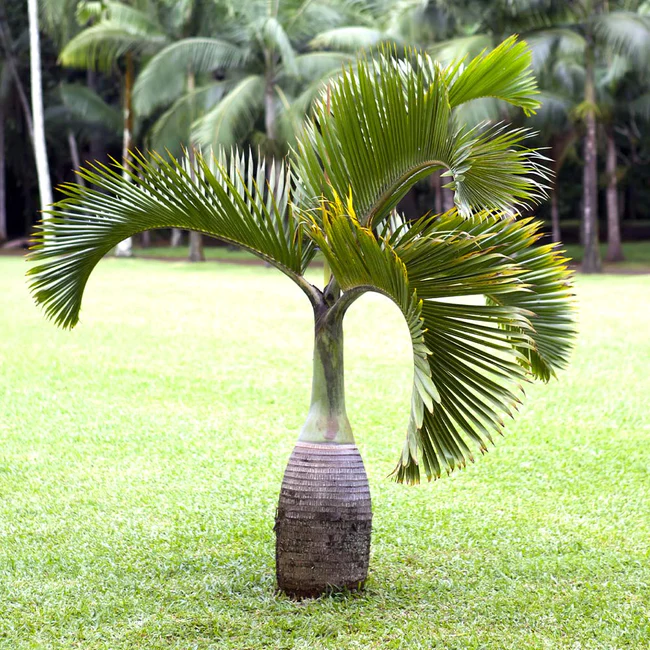
V. The right potting mix
When it comes to indoor palm tree care, the right potting mix is crucial for the health and longevity of your plant. A good soil mix should provide good drainage and aeration while retaining enough moisture and nutrients to support root growth.
A mix of peat moss, perlite, and vermiculite is a popular choice for indoor palm trees, as it provides a well-draining, yet moisture-retaining environment.
Some gardeners, myself included, prefer a mix of coconut coir and perlite to improve drainage and maintain a balanced pH level.
Regardless of the specific mix you choose, make sure it is a high-quality mix and free of weed seeds, pathogens, and other contaminants that could harm your plant.
Additionally, be sure to select a pot size that is appropriate for the size of your palm tree, as over-potting or under-potting can also negatively impact its growth and overall health.
VI. Over or under potting
Over-potting or under-potting can have a significant impact on the health of your indoor palm tree.
Over-potting occurs when a plant is placed in a new pot that is too large for its size, which can lead to waterlogged soil and root rot.
On the other hand, under-potting can cause a plant to become root-bound, where the roots have grown so densely that they are unable to take in enough water and nutrients. This can lead to stunted growth and yellowing leaves.
To avoid these issues, it is important to choose a pot size that is appropriate for the size of your indoor palm tree.
A pot that is only slightly larger than the root ball of your plant is ideal, as this allows room for the roots to expand and take in water and nutrients, but does not provide so much extra space that the soil becomes waterlogged.
If you are unsure of the appropriate pot size for your indoor palm tree, a general rule of thumb is to choose a pot that is about 2-3 inches larger in diameter than the current pot, but not more than 1/3 larger.
Additionally, it is a good idea to regularly check the soil moisture levels and ensure that your indoor palm tree is not becoming over-watered or under-watered.
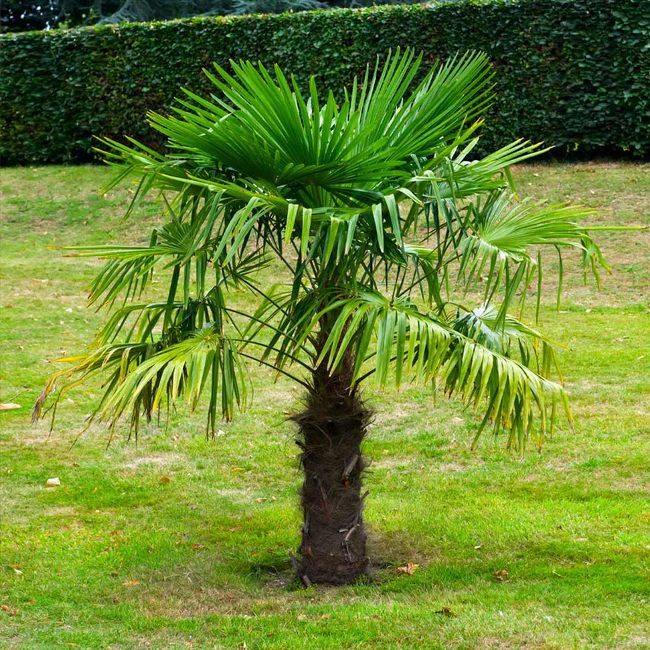
VII. Watering & Humidity
Proper watering and humidity are key to keeping your indoor palm tree healthy and thriving.
Indoor palm trees have specific needs for moisture levels, and it’s important to understand how to water your plant correctly to avoid over or underwatering.
In this section, we’ll explore the ideal watering and humidity conditions for indoor palm trees, as well as tips for maintaining the right balance of moisture in your indoor environment.
Importance of Proper Watering:
Proper watering is critical to the health and well-being of indoor palm trees. Over or underwatering can cause serious harm to your plant, leading to root rot or drought stress, respectively.
It’s important to understand the specific watering requirements for your indoor palm tree species and to water it consistently to avoid damaging your plant.
How Often to Water Indoor Palm Trees:
The frequency with which you water your indoor palm tree will depend on a variety of factors, including the species of the plant, the size of the pot, the temperature and humidity of the room, and the amount of light the plant is receiving.
As a general rule, most indoor palm trees should be watered when the top inch of soil is dry.
Poke your finger into the top inch of the soil. If it’s dry it’s time to water. You could also consider using a moisture meter to test your soil moisture.
Signs of Over-Watering or Under-Watering:
It’s important to be able to recognize the signs of overwatering or underwatering in your indoor palm tree.
Overwatering can cause yellowing or browning of the leaves, while underwatering can cause the leaves to become dry and brittle.
If you suspect your indoor palm tree is getting too much water, or not enough water it’s important to adjust your watering schedule accordingly.
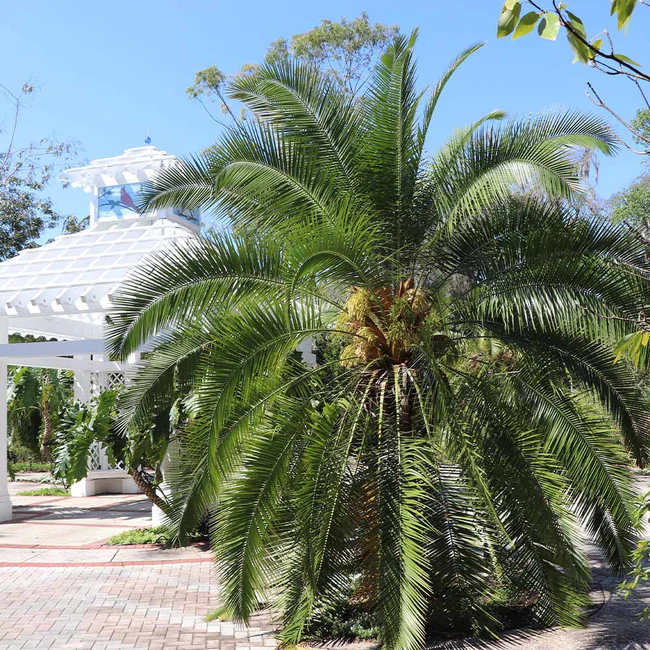
Role of Humidity in Indoor Palm Tree Care:
Humidity is an important factor to consider when caring for indoor palm trees, as many species are native to tropical regions and require high levels of moisture in the air.
Low humidity can cause the leaves of your indoor palm tree to become dry and brittle, leading to leaf drop and stunted growth.
How to Increase Humidity for Indoor Palm Trees:
There are several ways to increase humidity levels for indoor palm trees, including using a humidifier, misting the leaves regularly, or placing a tray of water near the plant.
It’s also important to consider the use of a pebble tray, which can help to create a micro-climate of high humidity around your indoor palm tree.
By providing your indoor palm tree with the right level of humidity, you can keep it healthy and thriving for years to come.
VIII. Fertilization & Soil
Fertilization and soil are two key components to maintaining a healthy indoor palm tree. The right type of soil and appropriate fertilization schedule will ensure that your plant is getting the necessary nutrients to grow strong and lush.
In this section, we’ll explore the types of soil and fertilizers that are best for indoor palm trees, as well as the timing and frequency of fertilization and the signs of over- or under-fertilization.
Nutrient Requirements for Indoor Palm Trees:
Indoor palm trees have specific nutrient requirements that must be met in order to maintain optimal health.
These requirements include adequate levels of nitrogen, phosphorus, and potassium, as well as micronutrients such as iron, magnesium, and calcium.
Understanding the nutrient needs of your indoor palm tree species is key to providing it with the right type of fertilizer.
Types of Fertilizers for Indoor Palm Trees:
There are several types of fertilizers available for indoor palm trees, including liquid fertilizers, slow-release fertilizers, and organic fertilizers.
Each type of fertilizer has its own advantages and disadvantages, and the best choice for your indoor palm tree will depend on the species and your specific care needs.
I like using slow-release fertilizer spikes, They are easy to use, convenient and take the guesswork out of fertilizing.
How Often to Fertilize Indoor Palm Trees:
The frequency with which you fertilize your indoor palm tree will depend on a variety of factors, including the species of the plant, the size of the pot, and the growth rate of the plant.
If you use fertilizer spikes you will automatically fertilize every time you water.
As a general rule, indoor palm trees should be fertilized every 2-3 months, but specific requirements may vary depending on the species.
Ideal Soil Type for Indoor Palm Trees:
The ideal soil type for indoor palm trees is a well-draining, peat-based potting mix or a coco coir and perlite mix.
This type of soil allows for adequate moisture and air circulation, which is essential to the health of your indoor palm tree.
It’s important to avoid using heavy, dense soil, as this can lead to root rot and other issues.
How to Repot Indoor Palm Trees:
Repotting is an important part of indoor palm tree care, as it provides your plant with fresh soil, encourages new growth, and allows for adequate root development.
Repotting should be done every 2-3 years, or when your indoor palm tree has outgrown its current pot.
The best time to repot an indoor palm tree is in the spring when the plant is actively growing. Choose a pot slightly larger than the original pot.
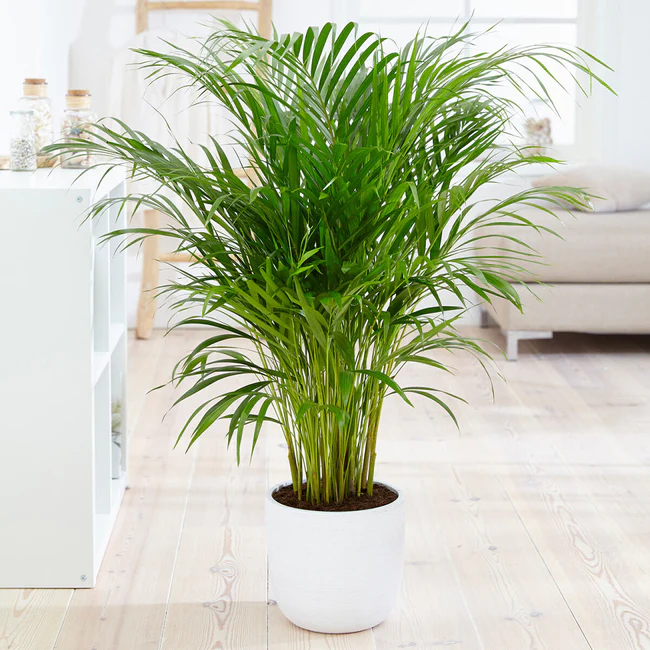
IX. Pests & Diseases
Pests and diseases can be a common problem for indoor palm trees, as they can quickly affect the health and appearance of your plant.
It’s important to be aware of common pests and diseases that can impact indoor palm trees, as well as the signs to look for and the treatments available.
In this section, we’ll explore the most common pests and diseases that affect indoor palm trees, as well as the best practices for preventing and controlling them.
Common Pests Affecting Indoor Palm Trees:
Some of the most common pests that can affect indoor palm trees include spider mites, mealybugs, scale insects, and thrips. These pests feed on the sap of the plant, causing damage to the leaves and stems, and can also lead to the spread of disease.
Signs of Pest Infestation:
Signs of pest infestation on indoor palm trees may include discolored leaves, small webs or sticky residue, and visible insects or eggs on the plant.
It’s important to catch pest infestations early, as they can quickly spread and become difficult to control.
How to Control Pests on Indoor Palm Trees:
The best way to control pests on indoor palm trees is to prevent them from taking hold in the first place.
This can be done by maintaining good hygiene practices, such as regularly cleaning the leaves of the plant and avoiding overcrowding of plants.
If pests do become a problem, a variety of treatments are available, including insecticidal soap, and neem oil.
Common Diseases Affecting Indoor Palm Trees:
Some of the most common diseases that can impact indoor palm trees include root rot, fungal leaf spots, and yellowing of leaves.
These diseases can be caused by a variety of factors, including overwatering, poor soil conditions, and high humidity levels.
Prevention and Treatment of Indoor Palm Tree Diseases:
The best way to prevent indoor palm tree diseases is to provide the plant with proper care, including proper watering and fertilization, and maintaining good hygiene practices.
If a disease does occur, prompt treatment is essential to prevent it from spreading.
Treatment may include removing infected leaves or stems, improving soil conditions, and using a fungicide to control the spread of the disease.
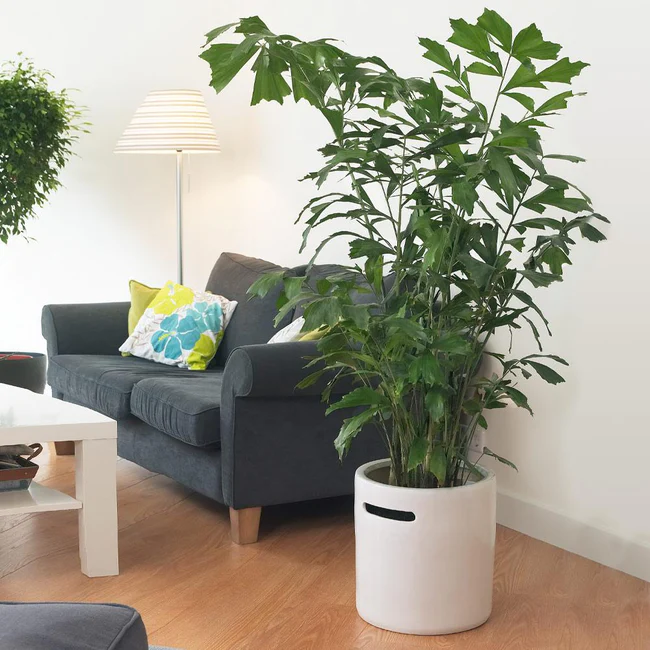
X. Pruning & Trimming
Keeping your indoor palm tree looking its best requires proper pruning and trimming.
These practices can not only improve the appearance of your plant but also promote healthy growth and prevent problems from arising.
In this section, we’ll explore the proper techniques for pruning and trimming indoor palm trees, including the best time to do so, the tools you’ll need, and the benefits of regular maintenance.
Why Prune Indoor Palm Trees:
Pruning indoor palm trees is an important part of maintaining their health and appearance.
Regular pruning can help to remove dead or damaged leaves and stems, promote the growth of new foliage, and prevent disease from spreading.
When to Prune Indoor Palm Trees:
The best time to prune indoor palm trees is during the growing season when new growth is actively taking place.
This allows the plant to quickly heal and recover from any cuts, and also promotes the growth of new leaves.
Proper Pruning Techniques for Indoor Palm Trees:
When pruning indoor palm trees, it’s important to use the proper techniques to avoid damaging the plant.
This includes using sharp, clean tools, and avoiding leaving stubs that can attract pests or harbor disease. Be careful not to injure the trunk.
Trimming Dead Leaves from Indoor Palm Trees:
Trimming dead leaves from indoor palm trees is an important part of maintaining their appearance.
Dead leaves can detract from the plant’s overall appearance and can also harbor pests or diseases.
When trimming dead leaves, it’s important to make clean cuts close to the base of the leaf, taking care not to damage the plant’s stem or leaves.
Regular trimming of dead leaves can help to keep indoor palm trees looking their best.
XI. How To Control Palm Tree Size
Because of the way palm trees grow you cant control size by pruning and heading back branches like on an apple tree. Palms grow from a central crown if you cut it off the plant will die. You can control size and shape to some extent by judicial pruning.
Pruning
Controlling the size of a palm tree can be accomplished through proper pruning and trimming. Pruning helps to maintain the overall shape and size of the palm tree and can also encourage new growth.
Trimming dead or yellowing leaves helps to keep the palm looking healthy and also prevents the spread of disease.
When pruning, it is important to use sharp, clean tools and make clean cuts. Avoid removing too much foliage at once, as this can shock the tree and impede its growth.
In addition to pruning and trimming, proper watering and fertilization practices can also play a role in controlling the size of your palm tree.
Using pot size, light and fertilization to control size
The size of the pot that an indoor palm tree is planted in can have a significant impact on its overall size and growth.
A pot that is too small can restrict the root growth, causing the tree to become stunted and preventing it from reaching its full potential size.
On the other hand, planting an indoor palm tree in a pot that is too large can result in a much larger palm tree. Overpotting can also cause root rot due to excessive moisture if you are not careful.
Palm trees do relatively well in small pots. By not overpotting you can help keep the size down. A pot with crowded roots will need more frequent watering as the roots get crowded.
In terms of light, indoor palm trees need bright, indirect sunlight to thrive. Over-exposure to direct sunlight may cause the plant to grow larger or cause leaves to yellow and scorch.
Too little light can result in slow growth and decreased health. Finding the right balance of light is important in controlling the size of indoor palm trees and ensuring their optimal health and growth.
Over-fertilizing can also cause excessive vegetative growth and create a larger plant.
To control the size of your palm tree striking the right balance can help. Before you buy an indoor palm you need to do your research and know what size your palm will eventually grow to.
Some palms are relatively small and bushy but some palms with trunks can get much larger, so consider the final size before you choose one.
FAQ
Q: What kind of palm tree is good for indoors?
A: Some popular species of palm trees that are well-suited for indoor cultivation include Kentia palm, Parlor palm, Bamboo palm, Areca palm, and Fishtail palm.
Q: Do palm trees do well indoors?
A: Yes, palm trees can thrive indoors if given proper care and conditions, such as adequate lighting, water, and humidity.
Q: What is the easiest palm tree to maintain?
A: Parlor palm is considered one of the easiest palm trees to maintain indoors due to its low light requirements and tolerance of low humidity levels.
Bamboo palm and Areca palm are known for being some of the easiest palm trees to grow indoors. They are relatively low-maintenance and do well in a range of lighting and humidity conditions.
Q: Do indoor palm trees clean the air?
A: Yes, some species of indoor palm trees have been shown to have air-purifying properties and can remove toxins from the air.
Q: How often should you water indoor palms?
A: The frequency of watering indoor palm trees can vary based on the species, size of the pot, temperature, and humidity levels. Palms prefer moist soil but it’s important to check the soil regularly and only water when the top inch of soil is dry.
Q: Do indoor palm trees give off oxygen?
A: All plants, including indoor palm trees, release oxygen through the process of photosynthesis.
Q: Do indoor palms need full sun?
A: No, indoor palm trees do not typically require full sun. Most species prefer bright indirect light or indirect sunlight but some can tolerate partial shade or lower light levels.
Q: Where do you put an indoor palm?
A: Indoor palm trees can be placed in any room that has bright, indirect light. Avoid direct sun exposure, which can cause the leaves to burn.
Q: How long do indoor palm trees last?
A: The lifespan of indoor palm trees can vary depending on the species and the care it receives. With proper care, many species of indoor palm trees can live for 75-85 years.
Q: Why does my palm have brown tips?
A: Brown tips on indoor palm trees are often caused by a combination of factors, including over-fertilizing, over-watering, low humidity, and exposure to dry air.
Q: Should I cut off brown palm leaves indoors?
A: Yes, brown or yellow leaves on indoor palm trees should be trimmed to maintain the plant’s appearance and encourage healthy new growth.
Q: Should I mist my palm plant?
A: Misting is not necessary for most indoor palm trees, but some species benefit from increased humidity. You can mist the leaves periodically to raise the humidity levels around the plant, but be careful not to over-water.
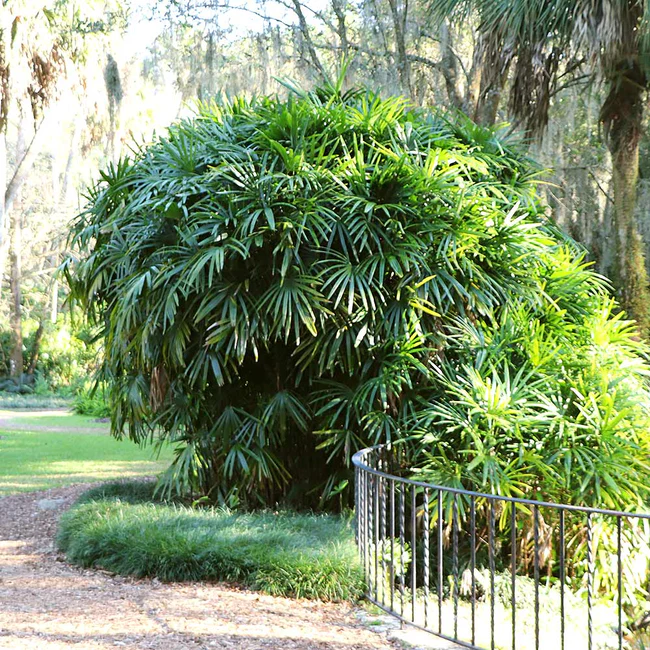
Conclusion
In conclusion, indoor palm trees can be a beautiful and low-maintenance addition to your home or office. With proper care and attention, these plants can thrive and provide you with years of enjoyment.
By understanding the needs of your indoor palm tree, including its light, water, and nutrient requirements, you can ensure its healthy growth and prevent problems from arising.
Whether you’re a seasoned plant enthusiast or new to indoor gardening, by following these tips and guidelines, you’ll be on your way to growing a thriving indoor palm tree that adds a touch of tropical beauty to your space.
Summary of Key Points Covered:
Throughout this guide, we have discussed various aspects of indoor palm tree care, including its definition, importance, and benefits, different types of indoor palm trees, location and lighting needs, watering and humidity requirements, fertilization and soil, pest and disease control, and pruning and trimming. By understanding these key points, you can provide the best care for your indoor palm tree and enjoy its beauty for many years to come.
Final Thoughts on Indoor Palm Tree Care:
Indoor palm tree care is an enjoyable and rewarding experience, especially when you see your plant thrive and grow.
With patience and attention to detail, you can successfully grow an indoor palm tree that adds a touch of tropical elegance to your space.
Remember that indoor palm trees are relatively low-maintenance plants, and with proper care, they will reward you with lush foliage and a healthy, thriving plant.
Encouragement to Continue Caring for Indoor Palm Trees:
We hope this guide has provided you with the information and inspiration you need to continue caring for your indoor palm tree.
Whether you’re new to indoor gardening or have been growing indoor palm trees for years, remember that proper care and attention can ensure the health and longevity of your plant.
So go ahead, water, fertilize, prune, and enjoy your indoor palm tree, and watch it grow into a beautiful and thriving addition to your home or office.

